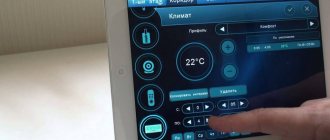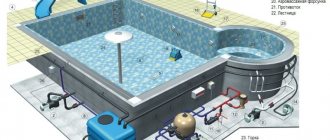The question of comfort in a house or apartment always remains open. It’s unpleasant to face a situation where it’s freezing outside, but the temperature at home is the same. The question is acute if a person is sensitive to temperature changes or if a child lives in the room. Remote temperature control systems for a house or apartment have come to the rescue.
The system faces the following tasks:
- maintain the set temperature;
- remotely turn on heating or cooling in the room;
- provide information about the current temperature;
- send an alarm signal in case of an accident or temperature exceeding the permissible value;
- remote control and temperature adjustment.
Do you want to take care of your household?
Order remote heating control from the company *** at reasonable prices here!
Temperature control is performed in two ways:
- via a Wi-Fi router and a “smart thermostat” , with the connection of a device that supports a wireless connection. A convenient application for a smartphone, tablet or PC will transmit all the necessary information. With it, you can set temperature settings and remotely control your home heating.
- GSM module , which is relevant for places without access to wired Internet or its complete absence.
Temperature for remote control is information in electronic form transmitted over a distance. The transmission method is cellular or GSM, Internet channel. All you need is an application on your smartphone and your ideal environment is already configured.
Convenient temperature monitoring
Live data and customizable temperature graphs are available through any web browser and the SAURES mobile app. We store data for a whole year. If you need to store longer, there is a paid option for this.
A demonstration room of the system with temperature sensors is available free of charge and does not require registration.
Test it now!
Go to your account
Boiler control
Most apartments today have heating boilers: gas or electric, and for private houses solid fuel boilers have begun to be used. All these options can be combined with one of the remote management tools. However, not all models support operation with automation and sensors. Sometimes you have to either change the boiler or select compatible equipment. In the latter case, a number of functions may not be available. Remote control of the boiler is implemented in the following modes:
- Automated system – work with maintaining specified parameters. Based on the data received from the sensors, the temperature is automatically adjusted and maintained at a given level or not.
- Sending alarm messages in the event of an emergency or repair situation. If such an accident occurs, the owner's smartphone or other paired device will receive a corresponding notification.
- Sending SMS messages or commands via messenger - commands are sent that are recognized by the automatic gas boiler.
Automatic control of ball valves, relays, thermal heads
In our system, using Wi-Fi controllers, you can use too high or too low a temperature as an event to control ball valves, relays, and thermal heads.
You can close or open a tap, control a pump or boiler, change the direction of water flow using three-way ball valves, maintain the room temperature by controlling a heating radiator, and much more.
Example scenario: Automatic pressure release in a street pipeline (for example, in an irrigation system) when frost occurs.
Example scenario: Automatic switching of central hot water supply to an electric boiler.
Example scenario: Automatically maintaining the room temperature within a given range using thermal heads.
Measuring temperature in the house, at the dacha and sending messages via SMS and call
What elements does a gsm thermometer (thermostat) from different manufacturers consist of:
1. Case 2. Board with parts
There are 2 main parts on the board: the controller (brains) - the atmega32a chip (or similar) and the SIM900 gsm chip, possibly from another manufacturer, which is responsible for communication.
Components of a gsm thermostat board
Their location on the board class=”aligncenter” width=”640″ height=”239″[/img]
Manufacturer location - 2
Thus, if the devices are made from the same parts, then there is no fundamental difference.
Choose those manufacturers who provide a more convenient guarantee in case of device failure.
This completes the description.
Technical characteristics and composition of the system:
1.GSM module. 2.Digital temperature sensors with a measurement range of -50 - +100 degrees, accuracy 0.5 degrees. 3. Element of informing about a 220 volt power outage at the dacha. 4. It is possible to additionally install an uninterruptible power supply and battery to the system so that the system can operate for a day without electricity. 5.It is possible to connect up to 5 thermometers. 6.The length of the cable from the unit to the thermometer can reach up to 20 meters. Cable brand KSPV 4x0.5 8. Additionally: it is possible to turn on any electrical load in the house, for example, an electric heater, remotely by telephone.
Archive article on this topic:
The most pressing issue is temperature control in the home heating system in winter. Since not everyone has antifreeze liquid in their heating system. Very often it uses plain water. And as we know from the laws of physics, at sub-zero temperatures it tends to freeze. But everything would be fine, but during the transition to the ice state, expansion occurs. As a result, the strongest metal pipes literally break. Therefore, many people think about how to make the heating system warn about a boiler stop or a power outage.
To do this, an electronic thermometer connected to a GSM module with a SIM card is installed at the dacha. This module is an analogue of a mobile phone that transmits information to the owner of the dacha or the plumbers serving the dacha about an emergency situation - simply a drop in temperature below a given level, for example +20 degrees Celsius in water or +5 degrees in air inside the house.
The photo shows exactly such a device. It consists of a plastic box with a GSM module, a power supply adapter and 2 thermometers. Removing one thermometer 10 cm from the block - it measures the air temperature. The second thermometer is on a 2-3 meter long cable. It can be mounted on a heating pipe. The system does not require any installation. Plugged it in and everything worked. A SIM card is already installed and configured inside.
A burglar alarm system is the choice of prudent people who value peace of mind and the safety of their family. But some people would prefer to be robbed twice rather than have their cottage burn down. And if you were given such a choice, what would you choose? The first option is considered more “humane”, since not all valuables in the house are lost forever. However, we should not forget that both fire and robbery are more than unpleasant things.
Installing warning devices in your dacha will help protect your home from the disastrous consequences of a fire and from the criminal actions of burglars. You can also find out the temperature at your dacha. Thanks to new technologies that are being actively introduced in the production of various types, there are now many ways to ensure the highest level of safety in the country.
Modern sensors for the home can be called “intelligent”, since some of them are connected to communication devices in such a way that in the event of an emergency, a signal about the incident is transmitted to the control panel of security services, which respond immediately.
Installing a security system will provide you with a sense of peace of mind about your property when you are away from your dacha. The price range for the security devices offered is quite wide, so you can always purchase the necessary equipment in accordance with your financial capabilities.
Your safety is only in your hands. And if, due to some circumstances, you cannot afford installation throughout the entire territory of the dacha, take care of at least some of its sections. At a minimum, an alarm system for a dacha should be represented by sensors that are installed on doors and windows. After all, every burglar first tries to enter the house through window or doorways. Some types of dachas emit a loud sound signal, thereby scaring away robbers, others will immediately notify you or the relevant security services
Two wireless technologies: Wi-Fi and NB-IoT
Our line of controllers includes models with Wi-Fi and NB-IoT modules. It's very easy to choose the right one.
- If your facility has a permanent Wi-Fi network, then choose Saures controllers with Wi-Fi.
- If there is no Wi-Fi network at the installation site, but there is NB-IoT network coverage (map on the MTS website), then use NB-IoT controllers.
- If both networks are present, then “choose with your heart”: the old and proven Wi-Fi or the new and advanced NB-IoT.
You can buy controllers for remote measurement of air temperature in our online store and from official dealers.
Go to the store
When purchasing an NB-IoT controller, data traffic for 6 years is already included in the price.
Types of remote heating control systems
There are two types of remote monitoring systems for heating an object, differing in the method of transmitting information and commands:
- via the Internet;
- via GSM.
Let's look at these types in more detail.
Control via GSM
This is the simplest type of remote control of a heating system. Its main element is the GSM thermostat (also called the GSM module). Essentially, it is a computer that provides:
- Maintaining the values of indoor air parameters programmed into its memory, depending on the day of the week and the current time.
- Transmitting information about the temperature and breakdowns of the heating system via SMS messages or calls to the user’s phone.
- Reception of SMS commands to change the heating operating mode and their execution.
A GSM thermostat has a controller that actually controls the heating equipment with connectors for connecting temperature sensors in rooms and outside the house and a boiler to it (usually the portable sensors themselves are included in the delivery of the thermostat) and one or more slots for SIM cards. Expensive models have a socket for connecting an Internet cable to the thermostat to expand the capabilities of the system. For example, organize dispatching, connect additional heating devices. To strengthen the signal, the thermostat also has a GSM antenna.
Remote control of the temperature of a country house via GSM is a common type of remote heating control. Its advantage is its affordable price and operation without wired Internet in the house.
Flaws:
- limited functionality;
- You need to pay for mobile phone service.
Internet control
The standard system configuration is as follows:
- an Internet gateway that connects to your home router;
- thermostat with programmer;
- radio control unit for the boiler.
The owner of a country house (dacha, etc.) uses a thermostat with a programmer to set the heating operating mode for the week. The same thermostat, via a Wi-Fi network, transmits information about the current temperature through a router to an Internet gateway, which sends it via WIRED Internet to a computer (tablet, smartphone) to the home owner. He can use commands (installation of software is required) to adjust the set operating mode of the thermostat, which controls the boiler through its radio unit.
In the extended version, you can control the operation of several heating devices via the Internet - boiler, radiators, “Heated floor” system, etc. To do this, it is necessary to install the appropriate radio units on this equipment. To work, you need to install a special application on your PC, tablet or smartphone.
The advantage of such a system is the widest possible functionality:
- control several heating devices;
- provide individual parameters for each room;
- providing complete information about heating operation;
- convenient reporting;
- dispatching capability.
Minus two:
- Technical - wired Internet is required, which in many cases is problematic for country cottages and houses. You also need a router.
- Financial – the system is more expensive than the control option via GSM.
What does it look like
When laid out, it all looks something like this:
In a simple version, you can send SMS commands to turn the heating on/off, receive reports on the status of the heater (on/off) and the measured temperature.
By the way, although it is written on the relay that it starts to operate at a voltage at the input of 3V, from five volts it did not operate reliably (it might not work immediately, it could turn off and turn on again). Therefore, the relay power supply was converted from a 12V input source - in this case, no problems were noticed.
How to choose a GSM module
The main component of any remote heating control system is a thermostat or GSM module. There are a large number of models on the market with different prices depending on functionality and brand.
For an inexpensive option, choose models that have standard functions, which we wrote about above. More expensive GSM modules allow you to program the heating operating mode for a week.
Consider the number of connectors for connecting sensors. Their number ranges from two to ten.
The most expensive models have a connector for connecting an Internet cable, as well as additional sensors - motion, smoke, etc. That is, the system also has security functions.
What tasks should a remote temperature control system perform?
Typically, a heating control system has two tasks:
1. Maintaining the required temperature in the house. At a minimum, it should ensure that the building itself and the heating system in it do not freeze. 2. Remotely turn on heating in a country house or in a smart home. For example, before the arrival of the owners, so that by the time of arrival all rooms have warmed up to the required temperature.
To solve these problems, the temperature control system must meet the following requirements:
1. Provide information about the current temperature in and outside the home. 2. Send alarms if the temperature is outside the acceptable range. 3. Have remote control, in particular, the ability to regulate the temperature in individual rooms or in the entire smart home in any convenient way (using a mobile application, via SMS messages, etc.). 4. Possibility of self-configuration and installation.










